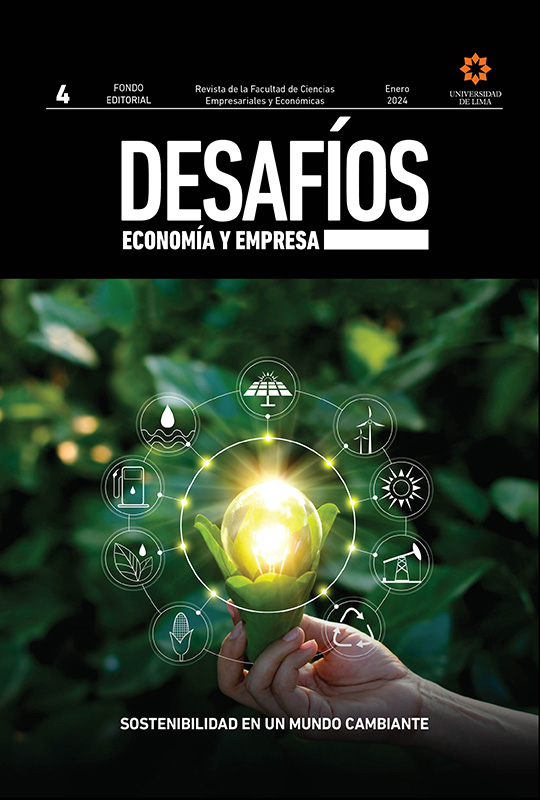Determinantes del capital humano desde la perspectiva de la innovación y el desarrollo tecnológico para América Latina
DOI:
https://doi.org/10.26439/ddee2024.n04.6280Keywords:
human capital, innovation, technology, Latin American countries, panel dataAbstract
This study examines the factors influencing human capital from an innovation and technological development perspective in eight emerging Latin American countries: Argentina, Brazil, Chile, Colombia, Ecuador, Mexico, Peru, and Uruguay. Using panel data and a fixed-effects model, the regression analysis includes variables such as internet usage, patents, fixed broadband, intellectual property, and scientific articles. The results demonstrate that all the variables have a statistically significant and positive impact on human capital. Internet, broadband, and patents are particularly relevant, as they have the highest coefficients. This emphasizes the importance of taking advantage of emerging technologies, measured through Internet access and broadband connectivity, for the development of skilled human capital. Moreover, the findings highlight the importance of continuous innovation, especially through patents, in strengthening human capital. Based on these findings, it is suggested that governments implement policies that promote innovation in society and the adoption of new technologies to enhance productivity levels.
Downloads
References
Acheampong, A. O., Opoku, E. E. O., Dzator, J., & Kufuor, N. K. (2022). Enhancing human development in developing regions: do ICT and transport infrastructure matter? Technological Forecasting and Social Change, 180. https://doi.org/10.1016/j.techfore.2022.121725
Becker, G. S. (1964). Human capital: a theoretical and empirical analysis with special reference to education. Columbia University Press.
Becker, G. S. (1993). Nobel lecture: the economic way of looking at behavior. Journal of Political Economy, 101(3), 385-409. https://www.jstor.org/stable/2138769
Bollen, L., Vergauwen, P., & Schnieders, S. (2005). Linking intellectual capital and intellectual property to company performance. Management Decision, 43(9), 1161-1185. https://doi.org/10.1108/00251740510626254
Breusch, T., & Pagan, A. (1980). The Lagrange multiplier test and its applications to model specification in econometrics. The Review of Economic Studies, 47(1), 239-253. https://doi.org/10.2307/2297111
Carrasco, A. S. E. (2001). Los retornos de la inversión en capital humano en Bolivia. Revista Análisis Económico UDAPE, 19, 1-26. https://www.udape.gob.bo/portales_html/analisisEconomico/analisis/vol19/art01.pdf
Clarke, P., Crawford, C., Steele, F., & Vignoles, F. (2010). The choice between fixed and random effects models: some considerations for educational research. IZA
Discussion Paper, (5287). https://docs.iza.org/dp5287.pdf
Crosby, M. (2000). Patents, innovation and growth. Economic Record, 76(234), 255-262. https://doi.org/10.1111/j.1475-4932.2000.tb00021.x
Faggian, A., & McCann, P. (2008). Human capital, graduate, migration and innovation in British regions. Cambridge Journal of Economics, 33(2), 317-333. https://www.jstor.org/stable/23601804
Griffith, A. S., & Altinay, Z. (2020). A framework to assess higher education faculty workload in US universities. Innovations in Education and Teaching International, 57(6), 691-700. https://www.tandfonline.com/doi/abs/10.1080/14703297.2020.1786432
Hagsten, E. (2015). Broadband connected employees and labour productivity: a comparative analysis of 14 European countries based on distributed microdata access. Economics of Innovation and New Technology, 25(6), 613-629. https://doi.org/10.1080/10438599.2015.1105547
Haini, H. (2019). Internet penetration, human capital and economic growth in the ASEAN economies: evidence from a translog production function. Applied Economics Letters, 26(21), 1774-1778. https://doi.org/10.1080/13504851.2019.1597250
Haller, S. A., & Lyons, S. (2015). Broadband adoption and firm productivity: evidence from Irish manufacturing firms. Telecommunications Policy, 39(1), 1-13. https://doi.org/10.1016/j.telpol.2014.10.003
Hausman, J. (1978). Specification tests in econometrics. Econometrica, 46(6), 1251-1271. https://doi.org/10.2307/1913827
Huang, Y., & Jim Wu, Y. (2010). Intellectual capital and knowledge productivity: the Taiwan biotech industry. Management Decision, 48(4), 580-599. https://doi.org/10.1108/00251741011041364
Iossifova, A. (2008). Research productivity, teaching relevance, and AACSB accreditation. Quality Management Journal, 15(4), 46-56. https://doi.org/10.1080/10686967.2008.11918204
Jiménez, M., Matus, J., & Martínez, M. (2014). Economic growth as a function of human capital, internet and work. Applied Economics, 46(26), 3202-3210. https://doi.org/10.1080/00036846.2014.925079
Mack, E., & Faggian, A. (2013). Productivity and broadband. International Regional Science Review, 36(3), 392-423. https://doi.org/10.1177/0160017612471191
Malamud, O., & Pop-Eleches, C. (2011). Home computer use and the development of human capital. The Quarterly Journal of Economics, 126(2), 987-1027. https://doi.org/10.1093/qje/qjr008
Malamud, O. (2019). The effect of home computers and the internet on children’s human capital development. DICE Report, 17(2), 34-40. https://ideas.repec.org/a/ces/ifodic/v17y2019i02p34-40.html
Maskus, K. E., & McDaniel, C. (1999). Impacts of the Japanese patent system on productivity growth. Japan and the World Economy, 11(4), 557-574. https://doi.org/10.1016/S0922-1425(99)00012-2
Mincer, J. (1974). Schooling experience and earnings. National Bureau Economics Research.
Nelson, R., & Phelps, E. (1966). Investment in humans, technology diffusion, and economic growth. American Economic Review, 56, 142-147. https://ideas.repec.org/p/cwl/cwldpp/189.html
Noser, T. C., Manakyan, H., & Tanner, J. R. (1996). Research productivity and perceived teaching effectiveness: a survey of economics faculty. Research in Higher Education, 37(3), 199-221. https://doi.org/10.1007/BF01730119
Owusu-Agyei, S., Okafor, G., Chijoke-Mgbame, A. M., Ohalehi, P., & Hasan, F. (2020). Internet adoption and financial development in sub-Saharan Africa. Technological Forecasting and Social Change, 161. https://doi.org/10.1016/j.techfore.2020.120293
Paul, C. W., & Rubin, P. C. (1984). Teaching and research: the human capital paradigm. The Journal of Economic Education, 15(2), 142-147. https://doi.org/10.1080/00220485.1984.10845062
Rojas, M., Angulo, H., & Velásquez, I. (2000). Rentabilidad de la inversión en capital humano en México. Economía Mexicana. Nueva Época, 9(2), 113-142. http://www.economiamexicana.cide.edu/num_anteriores/IX-2/01_MARIANO_ROJAS_113-142.pdf
Schultz, T. W. (1993). The economic importance of the human capital in modernization. Education Economics, 1(1), 13-19. https://doi.org/10.1080/09645299300000003
Verbeek, M. (2005). Models based on panel data. A Guide to modern econometrics. Wiley.
Wooldridge, J. M. (1994). Estimation and inference of dependent processes. Handbook of Econometrics, 4, 2639-2738. https://doi.org/10.1016/S1573-4412(05)80014-5
Yang, G., Wang, F., Huang, X., & Chen, H. (2022). Human capital inflow, firm innovation and patent mix. Journal of Asian Economics, 79. https://doi.org/10.1016/j.asieco.2021.101439
Young, B. (2006). A study on the effect of internet use and social capital on the academic performance. Development and Society, 35(1), 107-123. https://hdl.handle.net/10371/86685
Zahedi, M., Hosnavi, R., & Kangogar, A. (2016). Linking intellectual capital and intellectual property to company performance. Management Science Letters, 6(12), 753-758. https://doi.org/10.5267/j.msl.2016.10.005


